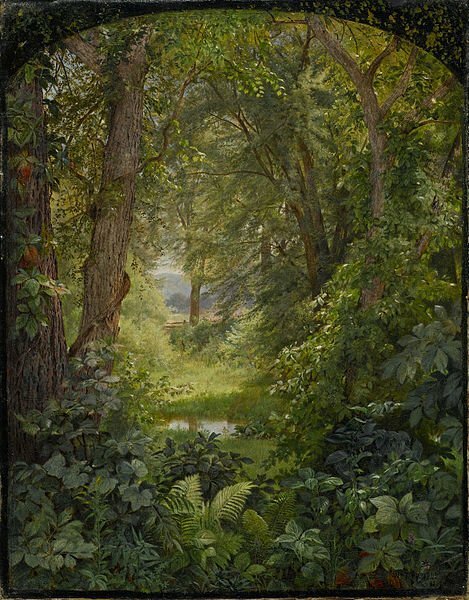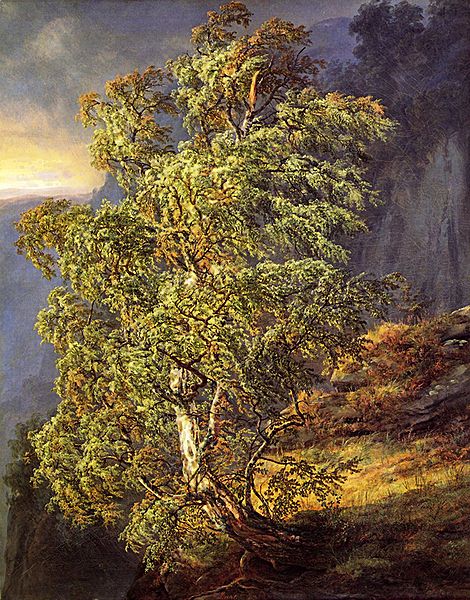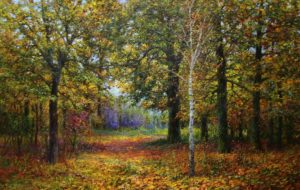Forest Terrain

Forest terrain can be divided into three categories: sparse, medium, and dense.
An immense forest could have all three categories within its borders, with more sparse terrain at the outer edge of the forest and dense forest at its heart.
The table below describes in general terms how likely it is that a given square has a terrain element in it.
| Category of Forest | |||
| Sparse | Medium | Dense | |
| Typical trees | 50% | 70% | 80% |
| Massive trees | – | 10% | 20% |
| Light undergrowth | 50% | 70% | 50% |
| Heavy undergrowth | – | 20% | 50% |
Trees

Birch Tree in a Storm
The most important terrain element in a forest is the trees, obviously. A creature standing in the same square as a tree gains partial cover, which grants a +2 bonus to Armor Class and a +1 bonus on Reflex saves. The presence of a tree doesn’t otherwise affect a creature’s fighting space, because it’s assumed that the creature is using the tree to its advantage when it can. The trunk of a typical tree has AC 4, hardness 5, and 150 hp. A DC 15 Climb check is sufficient to Climb a tree. Medium and dense forests have massive trees as well. These trees take up an entire square and provide cover to anyone behind them. They have AC 3, hardness 5, and 600 hp. Like their smaller counterparts, it takes a DC 15 Climb check to Climb them.
Undergrowth Vines, roots, and short bushes cover much of the ground in a forest. A space covered with light undergrowth costs 2 squares of movement to move into, and provides concealment. Undergrowth increases the DC of Acrobatics and Stealth checks by 2 because the leaves and branches get in the way. Heavy undergrowth costs 4 squares of movement to move into and provides concealment with a 30% miss chance (instead of the usual 20%). It increases the DC of Acrobatics checks by 5. Heavy undergrowth is easy to hide in, granting a +5 circumstance bonus on Stealth checks. Running and charging are impossible. Squares with undergrowth are often clustered together. Undergrowth and trees aren’t mutually exclusive; it’s common for a 5-foot square to have both a tree and undergrowth.
Forest Canopy It’s common for elves and other forest dwellers to live on raised platforms far above the surface floor. These wooden platforms often have rope bridges between them. To get to the treehouses, characters ascend the trees’ branches (Climb DC 15), use rope ladders (Climb DC 0), or take pulley elevators (which can be made to rise a number of feet equal to a Strength check, made each round as a full-round action). Creatures on platforms or branches in a forest canopy are considered to have cover when fighting creatures on the ground, and in medium or dense forests they have concealment as well.
Other Forest Terrain Elements Fallen logs generally stand about 3 feet high and provide cover just as low walls do. They cost 5 feet of movement to cross. Forest streams average 5 to 10 feet wide and no more than 5 feet deep. Pathways wind through most forests, allowing normal movement and providing neither cover nor concealment. These paths are less common in dense forests, but even unexplored forests have occasional game trails.
Stealth and Detection in a Forest
In a sparse forest, the maximum distance at which a Perception check for detecting the nearby presence of others can succeed is 3d6 × 10 feet. In a medium forest, this distance is 2d8 × 10 feet, and in a dense forest it is 2d6 × 10 feet.
Because any square with undergrowth provides concealment, it’s usually easy for a creature to use the Stealth skill in the forest. Logs and massive trees provide cover, which also makes hiding possible.
The background noise in the forest makes Perception checks that rely on sound more difficult, increasing the DC of the check by 2 per 10 feet, not 1.

Original oil painting by Vladislav Metyolkin
Common Hazards Within Forest Terrain
Forest Fires
Jungle Storms

Source: Jungle storm information from Pathfinder Chronicles: Heart of the Jungle
Equatorial storms can be both devastating and predictable. In many jungle areas, rainstorms come every afternoon and last anywhere from 20 minutes to 6 hours. In other areas, ferocious storms break suddenly and end quickly. These tend to deliver more precipitation than heavy wind, as the thick jungle growth protects those beneath it from the direct force of the storm. Still, in addition to the inconvenience of being wet and miserable, jungle storms bring with them the following dangerous possibilities.
Falling Trees Native flora, especially the tall trees which form the jungle’s canopy, have generally adapted to seasonal storms and rarely come down due to rainfall. At times, though, a particularly strong storm can erode the soil and pound a tree with enough force to cause it to topple, possibly setting off a chain reaction. Anyone in the path of a falling tree must make a DC 14 Reflex save to leap clear or take 3d6 points of damage. Fallen trees can block routes, but travelers can usually Climb over the trees, which measure anywhere from 5 to 20 feet in diameter. Fallen trees can, however, block river travel and require travelers to abandon their boats or to drag them out of the river and portage them around the obstruction.
Lightning Strikes Lightning strikes also occur during jungle storms, though they tend to be less frequent than in temperate thunderstorms. It is exceedingly rare for a creature to be struck by lightning, though such an unlucky character would suffer between 4d8 and 10d8 points of electricity damage from the strike. Due to the humid nature of the jungle, lightning strikes rarely produce forest fires, yet out on the plains it’s possible for a strike to ignite a drought-plagued field and start a wildfire.
Poisonous Foods One of the more common and effective defenses against predation in the jungle is simply being dangerous to eat. From an innocuous leaf to a brightly colored frog to the poison weeping injection vine, it seems everything in the jungle can cause chemical harm to the unwary. If a player is brave or naive enough to eat a jungle plant or animal she’s unfamiliar with or is maneuvered into doing so by well-meaning or mischievous locals you may want to roll on the following table to determine whether or not the item is poisonous. The effects listed below may either represent actual poison or simply compounds travelers have not properly adapted to.
Quicksand CR 3 Quicksand is nothing more than sand or loose soil that is supersaturated with water. This effect allows creatures to sink into the mixture much as if they’re settling into nothing more than silty water, but then requires them to fight the crushing weight of sand as if they had been buried alive to escape. The main dangers of quicksand are becoming trapped and unable to move or having one’s head submerged and suffocating. Even a trapped individual who manages to stay partway out of the quicksand is still at risk from the dangers of exposure and is easy pickings for the other denizens of the jungle.
Tainted Water Tainted water poses an attractive danger to a thirsty traveler. A character can make a DC 10 Survival check to tell fresh water from tainted water. Most jungle trackers know that still water holds the greatest potential for contamination, while fast-moving streams and headwaters are more likely to be fresh. A purify food and drink spell, of course, removes all doubt, and create water renders the question moot. Canny adventurers pack clean bowls or canteens with which to carry magically purified or created water and boil any water they’re forced to harvest from lakes or rivers (effectively eliminating the threat of disease). Tainted water can have any number of causes, from dangerous local plants leaching poison into the water, to a battleground or dung heap upstream, or even a simple animal corpse decaying and putrefying at the water’s edge. If a character drinks tainted water, she must make a DC 12 Fortitude save or contract Filth fever. The amount of water ingested does not modify the save or the severity of the disease in any way, as a thimbleful of tainted water can have the same effect as a bucketful. Wading through tainted water can also communicate Filth fever, as tiny drops of the water get on the character’s hands, clothes, and face and can later be transferred to the mouth, nose, or eyes as the character moves about. It is more difficult to contract a disease in this way, though. When wading or swimming through tainted water, a character receives a +2 circumstance bonus on her save to resist contracting Filth fever.
Leeches Leeches are prevalent in the jungle and are most commonly found in slow-moving rivers or stagnant ponds, though they can also live in deep or fast-moving water. Stagnant water in the jungle has a 50% chance of containing leeches, slow moving water a 25% chance, and swifter rivers a 10% chance. Ordinary leeches are disgusting but mostly harmless. They may attach themselves to characters moving through the water, but most leeches prefer to feed on carrion, plant matter, and other leeches. Still, it’s disturbing for even the most seasoned adventurer to emerge from a river and find sticky blobs of leech plastered to her skin, and though leeches themselves are not poisonous, they are capable of spreading blood-borne diseases from one victim to the next as they vomit the contents of their stomachs into the wound. Thus, you may wish to assign a percentile chance of contracting one of the following injury diseases: Bonecrusher (Dengue) Fever, Brainworms, Dysentery, Firegut, Greenscale, Malaria (Jungle Fever), Pulsing Puffs, Sleeping Sickness (save DC varies by disease).
Ghost Leech CR 1/2 Unfortunately, the standard leech is not alone in the rivers of the jungle. Both giant leeches and nauseating leech swarms make their homes here, and they are seldom content with a sip of the victim’s blood, preferring instead to drain her dry. In addition, streams are also home to the translucent terror known as the ghost leech. A ghost leech is a 6-inch-long leech with almost completely clear skin, appearing as little more than a ripple in the water as it moves. A gentle attacker with an anesthetizing poison, it can often attach itself to a humanoid or other prey animal without being noticed (Stealth +20). Once attached, the ghost leech quietly drains its host of blood, inflicting 1 point of Constitution damage each round that it’s attached. As it fills with blood, it gradually becomes more and more visible, taking a cumulative -5 penalty on Stealth checks and allowing a new Perception check to notice it for each point of Constitution it drains. The ghost leech detaches itself once it has dealt at least 3 points of Constitution damage and slithers back into the water. Ghost leeches have no other combat abilities and negligible hit points and AC; an adventurer can kill one easily by tearing it off and squishing it, assuming she notices it before it drops away and leaves her weakened and pale. As such, it works better as a natural hazard of CR 1/2 than as an actual combat encounter.
Flash Floods (CR 3) Heavy rains can cause rivers to swell and break free of their banks, turning valleys to rushing mudflows and filthy lakes. Experienced guides know to stay clear of rivers during rainstorms, but tropical storms often erupt quickly, and the torrential downpour can catch adventurers in a flash flood without warning. At other times, a storm some distance away can push swelling water down the river and catch travelers in a rushing wall of water.
A traveler can make a DC 20 Survival check to notice the telltale rise in water or other dangerous conditions that signal an impending flash flood. Success means the traveler and her allies have 1d4 rounds to prepare or reach high ground before the flood strikes. A flash flood sweeps past at a speed of 60 feet with enough force to knock down trees and toss boulders around (see fast-flowing water.) At the GM’s discretion, characters caught in a flash flood might suffer additional effects, outlined below.
Characters within 50 feet of a flash flood must make a DC 12 Reflex save or take 2d6 points of damage from hurtling debris. Any character wading through a river or within 10 feet of the river’s edge is caught in the flash flood when it erupts and is subjected to a bull rush (CMB +20). A successful bull rush indicates the character is swept away, taking 2d6 points of damage per round (a DC 12 Reflex save each round negates this damage). Swim checks are possible in a flash flood, but they are difficult due to the churning, raging waters and should be treated as stormy water (Pathfinder RPG Core Rulebook 108), with DC 20 Swim checks required to move through the torrent. Most flash floods last 3d6 minutes before subsiding, but on occasion longer flash floods may occur. It’s also important to note that certain animals may sense an impending flood before adventurers, and even if the player characters manage to reach the safety of high ground, they find themselves face to face with other jungle denizens who aren’t interested in sharing it.

 Buy me a coffee
Buy me a coffee